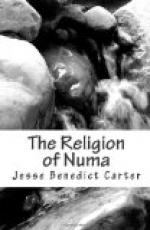With the death of Augustus the last chapter in the history of old Roman religion was closed. His was the last attempt to fill the spiritual need of the people with the old forms and the old ideas; for what he offered was in the main old though certain new ideas were mixed with it. From now on the lifeless platitudes of philosophy and the orgiastic excesses of the Oriental cults divided the field between them, and it was with them rather than with the gods of Numa or even with the deities of the Sibylline books that Christianity fought its battles. That too is a fascinating study, but it is quite another story and with the death of Augustus our present tale is told. And when we look back over the whole of it the main outlines become perhaps even clearer because of the details into which we have been compelled to go.
We see at the start the simple religion of an agricultural people still strongly tinged with animism and inheriting from an animistic past a certain formalism which is so great that it almost becomes a content. Toward the close of the kingdom we see this religion developing through Italic influences so that it takes into itself a certain number of elements which were absent from the older religion because they had no concomitants in daily life, but whose presence is now rendered necessary. These elements are especially the ideas of politics, trade, commerce, and the liberal arts. Then for a moment under Servius an equilibrium seems to have been reached, and a religion to have been brought into being which was simple enough for the old lovers of simplicity and varied enough to satisfy the new demands of the community. But this was not for long, for the spiritual conquest of Rome by Greece began then, three centuries before the physical conquest of Greece by Rome. The hosts of Greek deities invaded and captured Rome under the leadership of the Sibylline books, and though at first they had been kept outside the pomerium, even this iron barrier was melted in the heat of the Second Punic War, and the new Greek gods swarmed into the city proper. At the same time as a last heritage from the baleful books an Oriental goddess, the Magna Mater, was taken into the cult and into the hearts of the people, and the elements of decay were thus all present. These elements were threefold: the natural spiritual reaction resulting from the excesses of the period




